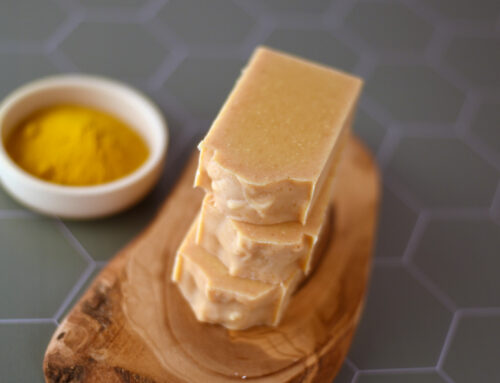One of the questions we get asked most when it comes to essential oils is how do you make them last in your soap? Some people will mention anchoring with clay or some other tricks. But honestly, the best thing you can do is create a well-rounded blend using top, middle and base notes.
Essential oils are categorized into different notes:
Top notes – Top notes are often the first thing that your nose picks up on. They are bright, sharp, moving and dancing aromas. Think peppermint and citrus – especially lemon. Top notes can sometimes be fleeing (highly volatile) from soap and can dissipate easily. You can certainly make a soap with top notes, but it is best if you add middle and base notes to anchor and round out the scent.
Middle notes – Middle notes round out and add complexity to a blend. They can help anchor more volatile top notes. Middle notes meld together your top and base notes; seemingly blending them into a pleasant aroma.
Base notes – These are your strong, pungent, heavy, grounding and anchoring scents. They are usually the last to evaporate, so leave a lasting impression.
When blending essential oils, try to include at least two of the note groups, if not all three in your blend.
Here are some common essential oils used in soap under each note category. Some essential oils can swing between categories depending on who you ask, so I’ve create two in-between categories.
Top Notes:
- Peppermint, cornmint, spearmint: Refreshing, cooling and stimulating. These give soap a fresh and clean smell.
- Lavender: Calming, relaxing and balancing.
Top-Middle Notes:
- Litsea: Bright and uplifting. Has a citrus/lemony scent. Helps to anchor more fleeting citrus essential oils in blends.
- Orange, lemon, grapefruit: Happy and uplifting. Can improve any mood. Choose folded citrus oils for better staying power in soap.
- Lime, bergamot: Bright like other citrus oils, but also musky. Add depth and complexity to a blend.
- Clary sage: Sweet and herbaceous, mood enhancing and balancing.
Middle Notes:
- Tea tree: Medicinal, fresh camphorous scent.
- Eucalyptus: Minty, camphorous, sharp and pungent.
- Ylang-Ylang: Warm, sweet floral. A romantic scent that eases the mind and eases tension.
Middle-Base Notes:
- Clove bud, cinnamon leaf, cassia, nutmeg: Warm and spicy. Spice essential oils can deepen any blend and add complexity. Great for holiday blends. They can cause a soap to trace quickly, so hand-stir if your blend contains a spice. Pay careful attention to usage rates; spices can only be used in tiny amounts of soap.
Base Notes:
- Patchouli: Spicy, musky, and sweet. Grounding and balancing. A wonderful base note to add depth and complexity to any blend. If you don’t like patchouli by itself, you might end up liking it in a blend.
- Cedarwood: Woody and clean smelling.
- Frankincense: A green wood and earthy scent.
Here are some well-rounded blends that you might try in your cold process soap. I’ll provide percentages so you can turn those percentages into grams for your recipe. As always, run your essential oils through the Essential Oil Calculator (eocalc.com) to make sure you’re using safe amounts in your soap.
- LAVENDER 55%
- LITSEA 20%
- TEA TREE 5%
- PATCHOULI 20%
- LAVENDER 55%
- ORANGE 22%
- CINNAMON LEAF 3%
- CEDARWOOD 20%
- LAVENDER 40%
- ORANGE 40%
- PATCHOULI 20%
- PEPPERMINT 40%
- LITSEA 40%
- CEDARWOOD 20%
Hopefully this helps you with your essential oil blending for your cold process soap!
Do you want more essential oil blends for cold process soap? Check out our eBook, Essential Oil Blends for Handcrafted Soap and our #1 selling recipe eBook, Lovin Soap Studio’s Cold Process Soap Recipes, which includes 50 recipes for cold process soap and 64 essential oil blends!
Happy Essential Oil Blending!
Amanda Aaron







I’m particularly excited about the oil infusion method. Not only does it sound like a great way to boost the scent’s longevity, but it also adds an extra layer of luxury to the soap.
Thank you for sharing your expertise in such a clear and approachable way.
Such a well-written article with practical tips. Your recommendations make it easier to choose the right oil blends for making cold process soap. This article might be a great resource for beginners.
Using Kaolin clay mixed with your hard to stick EO’s can also help to anchor the scent in the soap 🙂 1tsp PPO
I always have this issue too, with essential oils sticking. I love the smell of citrus, but it’s always so hard to get the smell to come through in the end. I think I do like orange 10X the most.
Try using Litsea Cubeca to anchor citrus notes as they are flighty and you are correct in using folded citrus oils to get best results. Also, when using a blend that is anchored with a base note it is best to let your blend mingle overnight (before use), minimum, to get best results as the anchoring base note needs time to grab onto the lighter, more flighty top notes.
Try using Litsea Cubeca to anchor citrus notes as they are flighty and you are correct in using folded citrus oils to get best results. Also, when using a blend that is anchored with a base note it is best to let your blend mingle overnight (before use), minimum, to get best results as the anchoring base note needs time to grab onto the lighter, more flighty top notes.
Another good anchor/base for citrus that doesn’t really show in the final blend much is amyris.